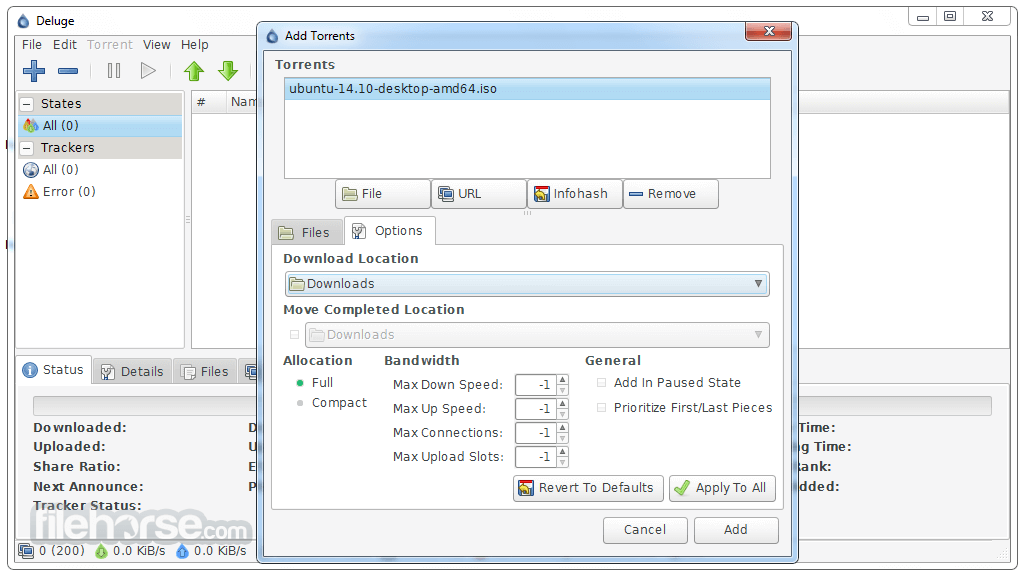

- #DELUGE BITTORRENT CLIENT INSTALL#
- #DELUGE BITTORRENT CLIENT DOWNLOAD#
- #DELUGE BITTORRENT CLIENT FREE#
- #DELUGE BITTORRENT CLIENT TORRENT#
Open the Deluge preferences by clicking “Edit”?”Preferences.” On the side of the window that will open, you can find the “Interface” tab.
#DELUGE BITTORRENT CLIENT INSTALL#
$ sudo apt install deluge-gtk Connect To Your Server Just install the client with your package manager. LinuxĪs you’ve probably guessed, the Linux process is very easy.
#DELUGE BITTORRENT CLIENT FREE#
Feel free to click through the wizard, and accept the defaults. The installation process is fairly standard.
#DELUGE BITTORRENT CLIENT DOWNLOAD#
Go to the Deluge download page, and grab the latest release for Windows. Deluge is open source and readily available across multiple platforms. You can now install the Deluge client to connect to your server. $ sudo systemctl enable deluged Install The Client If the service is up and running, make the change permanent by enabling the service. $ sudo systemctl start deluged $ sudo systemctl status deluged Test it out by starting up the service and checking the status. # Time to wait before forcefully stopped. In it, put the following: ĭescription=Deluge Bittorrent Client Daemon Create a file at /etc/systemd/system/rvice. Don’t worry, this is actually provided in the Deluge documentation. Since you want Deluge to start up automatically with the Raspberry Pi, you’re going to need to write a simple systemd service. Add your user records in the following pattern. The file is located at / var/lib/deluge/.config/deluge/auth. You need to add login records for your users. You can do that by looking up the process and killing it. Change to your Deluge user, and open up the Deluge console. In order to allow connections to your server from other computers, you need to enable remote connections. $ sudo apt install deluged deluge-console You’re finally ready to install deluge on your server. $ sudo ufw allow in on tun0įinally, allow contact to your VPN’s DNS server. $ sudo ufw default deny incomingĪllow all connections from the computer itself and the local network. Now, tell UFW to block everything by default. Once you have UFW, you can start setting up your rules. Start by downloading UFW to make firewall management much easier. Thankfully, that’s something that’s very easy to do on Linux systems with a firewall. If you’re using torrents behind a VPN, your probably want a reliable killswitch that will cut off your connection of you lose contact with the VPN. $ sudo systemctl enable Create A VPN Killswitch The process will take a while, so be patient. When everything looks correct, click the button to flash your image. In the first section, select your image file. The program breaks the process down into three simple steps. Once you have Etcher, open it up or install it. Download the correct version for your OS. If you don’t already have a preferred tool for flashing images to SD cards, there’s a great cross-platform application, Etcher, that you can use on any operating system to easily flash your image. Then, insert your MicroSD card into your computer. You’re not going to need a desktop environment on your server. Go over to the Raspberry Pi Foundation’s download page, and get the latest release of Raspbian Lite.
#DELUGE BITTORRENT CLIENT TORRENT#
It’s also the perfect option for setting up the Pi as torrent server. Raspbian is the default operating system for the Raspberry Pi.

Your server will always be running in the background, even when your computers are off or you’re not even home.A server is also much easier to manage. You can check if something’s done downloading from outside your house or change the priority of your downloads on the fly.Having a dedicated server also means that you can turn off your computers without worrying about stopping your download progress. You can also easily access and manage your torrents from anywhere. You can use a laptop or computer in an entirely different room. That means, if you want to download something, you don’t necessarily need to be on the same computer.


 0 kommentar(er)
0 kommentar(er)
